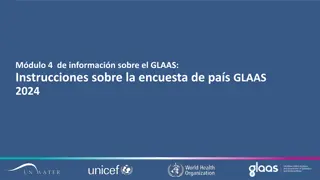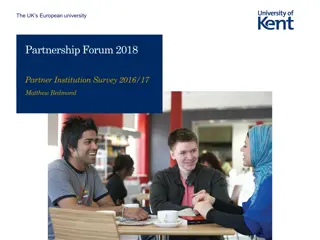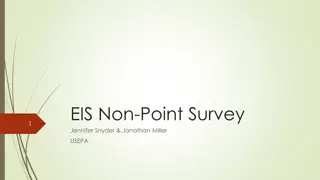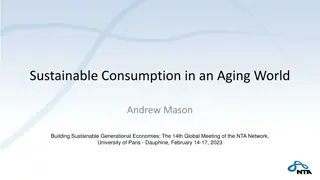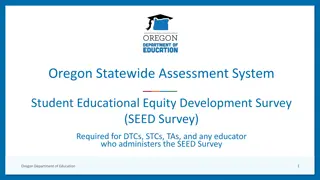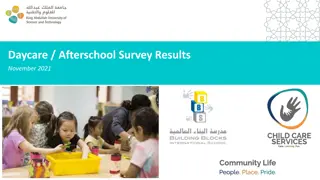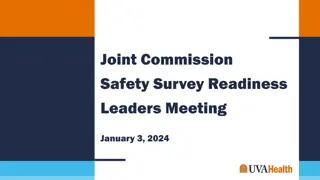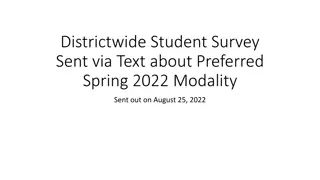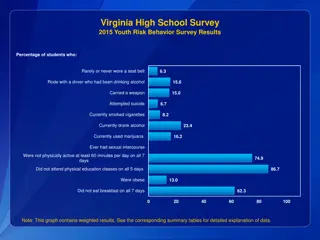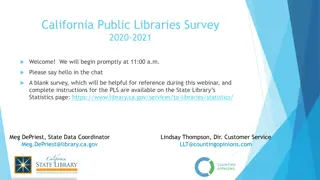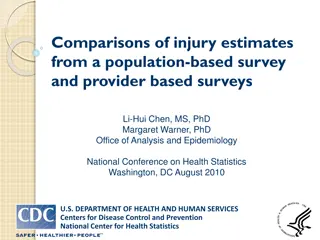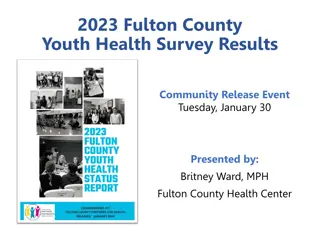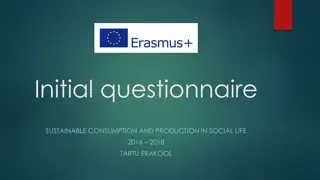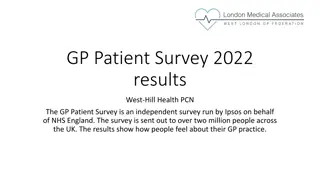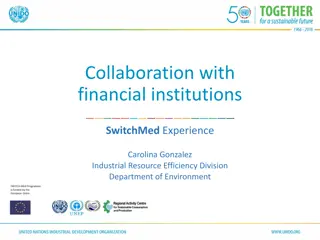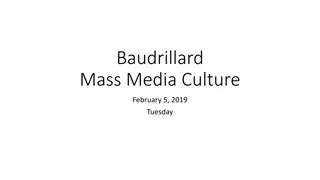Sustainable Consumption Survey Results
The survey conducted among second-grade students of a secondary school in Italy focused on testing knowledge of sustainable consumption issues. Questions ranged from food waste to energy-saving tips, providing insights into students' understanding of environmental challenges.
Download Presentation

Please find below an Image/Link to download the presentation.
The content on the website is provided AS IS for your information and personal use only. It may not be sold, licensed, or shared on other websites without obtaining consent from the author. Download presentation by click this link. If you encounter any issues during the download, it is possible that the publisher has removed the file from their server.
E N D
Presentation Transcript
INITIAL QUESTIONNAIRE INITIAL QUESTIONNAIRE Sustainable consumption 2016-2018 IPSSAR PRINCIPI GRIMALDI MODICA RAGUSA ITALY
INTRODUCTION The survey was conducted on October 10 among second-grade students of secondary school. In total, 81 students took part in the survey which consisted of 20 closed questions, in which only one response was correct, and 5 questions in which students should select one answer that best suits their preferences. The survey is divided into five parts and has been designed to test basic knowledge of each subtopic appointed to the partners: Part I : Unsustainable consumption and threats Part II: Healthy leaving & food & sport Part III: Employment and economy Part IV: Environment & climate change & environmental protection PartV: Education and innovation .
Unsustainable consuption and threats 1. World Food Day, established in 1979 by Food and Agricolture Organization (FAO), is celebrated every year: a) 16 October b) 22 April c) 22 March d) 2 September The correct answer was given by 59 students out of 81. 2. How much food is wasted every year in Europe? a) 1 000 tons b) 10 000 tons c) 50 000 tons d) 100 000 tons The correct answer was given by 53 students out of 81.
3. Smog occurs most often as: a) low residual mixture of fog and pollution in industrialized urban areas during windless weather b) cloud of pollution in rural areas formed during field work and carried by the wind c) thick fog free from impurities, which appears in the morning and making difficult to drive d) a mixture of ozone, oxides of sulfur and nitrogen present in the ozone layer The correct answer was given by 33 students out of 81.
4. One of the ways to save electricity is: a) Buying devices with thermostats. b) Setting the refrigerator close to a heat exchanger for example radiator c) Using light bulbs with the lowest brightness, d) Setting supreme washing program in your washing machine The correct answer was given by 29 out of 81 5. Before throwing the glass jar you need to: a) Wash the jar and then smash it b) Do not remove the labels for easy identification c) Spin the jar, so that water does not get into it d) Remove the metal or plastic nut The correct answer was given by 29 out of 81
Healthy living & Food & Sport 6. A healthy diet: eliminates all use of sugars and salt is low in fat provides a variety of different foods both b and c The correct answer was given by 17 out of 81 a) b) c) d) 7. The majority of daily calories should come from: breads, cereals, rice and pasta products fruits and vegetables milk, yogurt and cheese meat, poultry, beans or eggs The correct answer was given by 53 out of 81 a) b) c) d)
8. Sources of protein include: a) chicken and fish b) beans and peas c) eggs d) all of the above The correct answer was given by 16 out of 81 9. A precompetition meal should: a) allow for the stomach to be relatively full at the start of competition b) minimize gastrointestinal distress c) provide protein fuel for the muscles d) provide carbohydrate fuel for muscles The right answer was given by 17 out of 81
10. In general, a solid meal should be eaten _____ prior to competition. a) the day b) 3-4 hours c) 1 hour d) none of the above The correct answer was given by 70 students out of 81
Employment and Economy 11. The workforce in the country is represented by: a) all the people from this country b) all the people in a country who are over 18 years old c) all the people who are capable of working, who have physical and intellectual potential d) all the people who are provided with unemployment benefits/compensation The correct answer was given by 34 students out of 81 12. The word `unemployment` refers to the: a) lack of a job abroad b) lack of a job in a country c) lack of a well paid job d) lack of a paid job The correct answer was given by 12 students out of 81
13. The gross domestic product (GDP) consists of: a) all the goods and services produced in an economy over a period of time b) all the goods produced in a country c) all the services provided/fulfilled in a given territory d) all the goods consumed by population The correct answer was given by 50 students out of 81 14. The products are defined as: a) all the objects or goods obtained in the production process, designed for the customers b) all the activities performed for customers at request, at a certain time c) the entire amount of tourism activities in Romania d) only products that can be found in the grocery stores, which are intended for immediate consumption The correct answer was given by 46 students out of 81
15. The salary received by the working people is: a) the amount of money an employee receives in return for the service/work he/she has performed at a work place b) the amount of money that one person receives from another person without having to work c) the amount of money that a student receives from the Government d) the amount of money a person needs to live decently The correct answer was given by 32 students out of 81
Environment & Climate change & Environmental protection 16. What do you call a substance that pollutes the air, water or soil? a)Pollutant b)Pesticides c) Acid d) Sulfur The correct answer was given by 22 students out of 81 17. Global Warming will cause increase of a) Heat waves b) Hurricanes c) Both d) None of them The correct answer was given by 22 students out of 81
18. Which of these human activities contributes the most for global warming? a) Using fossil fuels. b) Cutting down trees. c) Riding bicycles. d) None of them The correct answer was given by 38 students out of 81 19. Which layer protects the Earth from UV rays? a) Oxygen b) Nitrogen c) Ozone d) Hydrogen The correct answer was given by 50 students out of 81
20. What do you call renewable safe sources of energy a) Alternative energies b) Bio-energies c)Solar energies d) Wind energy The correct answer was given by 27 students out of 81
Education & innovation 21. Can every student be creative? a) some of them b) most of them c) all of them d) none of them 14 students answered D 16 students answered A 18 students answered B 33 students answered C
22. In your opinion what is the most effective for enhancing creative learning? a) allowing students to make mistakes b) using technologies c)experiences such as work and play or risk taking d) discipline 19 students answered A 21 students answered B 25 students answered C 16 students answered D
23. Which certain technologies are the most important for learning? a) educational software b) interactive white boards c) social media d) virtual learning environments 23 students answered A 23 students answered B 22 students answered C 13 students answered D
24. I like a) preparing additional materials from different sources for my favourite classes b) updating my own knowledge c) doing nothing extra d) preparing myself before every lesson 24 students answered A 18 students answered B 19 students answered C 20 students answered D
25. Do you like when a teacher ? a) demonstrates and presents material using technologies b) prepares handouts and additional materials c) uses teaching software that my school has a license d) uses the computer room for classes 37 students answered A 29 students answered B 10 students answered C 5 students answered D
Conclusion Questions 1,2, 7, 10, 13, and 19 were the easiest for our students. Question 1 (80% of the students chose a proper answer), question 2 (43 %), 7 (43%), 10 (57%), 13 (40%) and 19 (40%). The most difficult made was question 12 about the meaning of the word unemployement , only 10 % of students indicated the right answer, questions 6, 8, 9 and 17, only 14% of students indicated the right answer . In the last five questions concerning education and innovation, in question 21, 33 respondents out of 81 answered that all students should be creative. 25 students believe that work, play or taking risks is important in creative learning. 23 students answered that educational software is the most important in the learning process, while only 13 believe that virtual learning environments are important for learning. 24 students like preparing additional materials for classes, but 18 students do not like to do anything extra. In question 25, 37 students liked when the teacher demonstrates wide range of material using modern technologies.
Conclusion In PE classes it is needed to pay more attention to the topics related to sport activities; The Food Science teacher should help students to improve their knowledge about the importance of certain nutrients present in food and what are the most correct eating habits to achieve an healthy lifestyle; In geography, chemistry and nature classes more attention should be paid to discuss the topics related to the renewable sources energy and teach students a good recycling practice.











